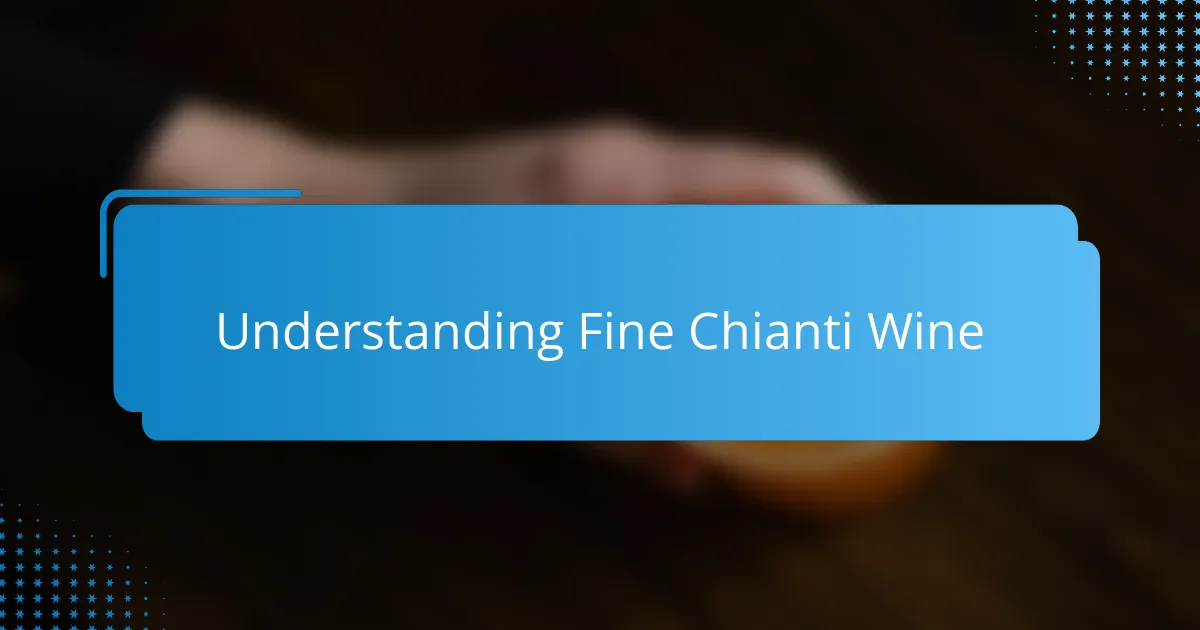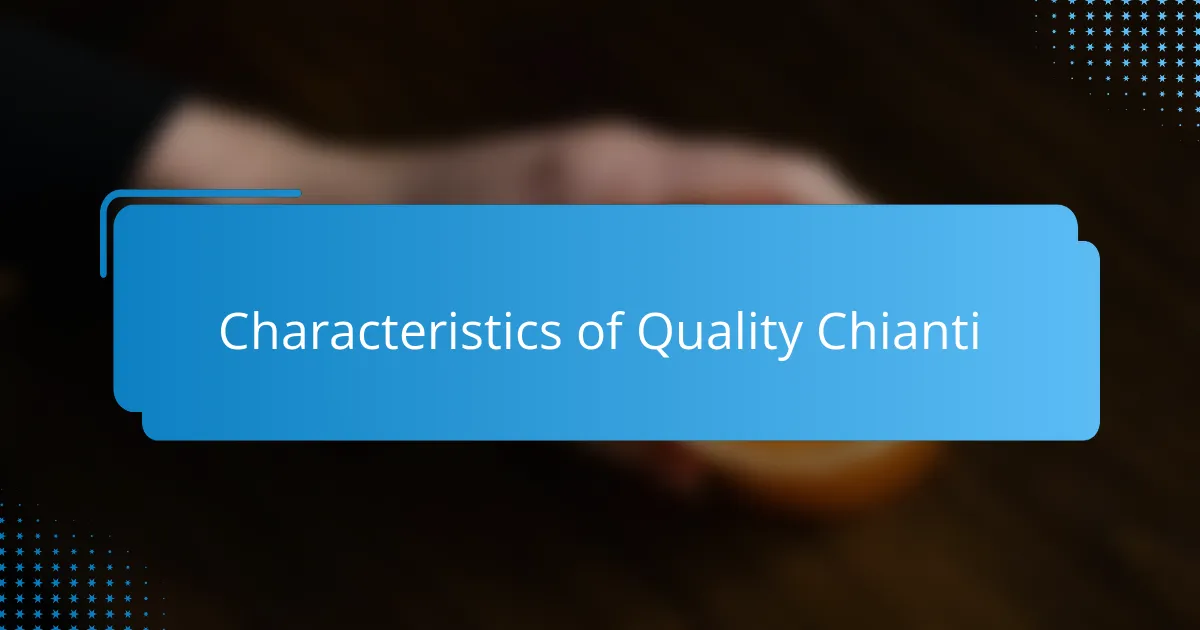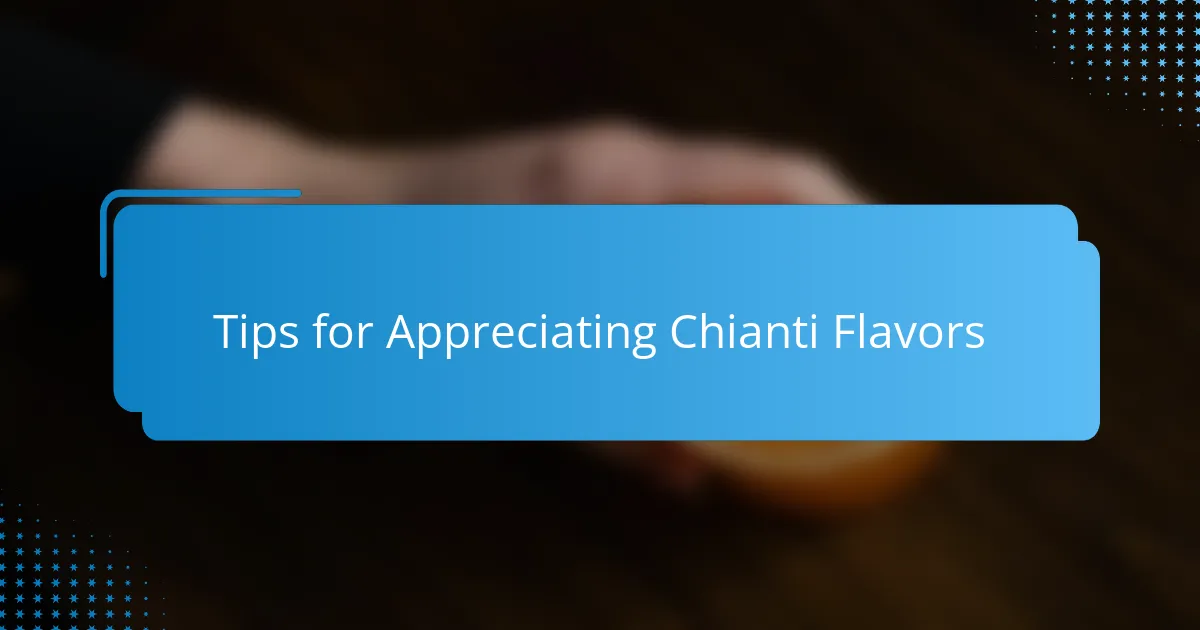Key takeaways
- Fine Chianti wines, primarily made from Sangiovese grapes, embody Tuscany’s heritage and craftsmanship.
- Key characteristics include bright ruby color, vibrant acidity, and complex earthy flavors that enhance the tasting experience.
- Letting Chianti breathe and thoughtfully pairing it with food can elevate its flavors and complexities.
- Exploring different subregions and older vintages enriches appreciation and understanding of Chianti.

Understanding Fine Chianti Wine
Fine Chianti wines are much more than just a drink; they carry the essence of Tuscany’s rolling hills and centuries-old traditions. When I first tasted a well-aged Chianti, I was struck by its balance—vibrant acidity paired with earthy, cherry notes that seemed to tell a story in every sip. Have you ever wondered what makes Chianti stand out among Italian reds?
What sets a fine Chianti apart is its careful production, primarily from Sangiovese grapes, which give the wine its distinctive character and complexity. I remember a particular evening at a small wine bar where the sommelier explained how the DOCG classification guarantees authentic quality, making every glass feel like a taste of genuine Italian heritage.
Understanding fine Chianti means appreciating not just its flavor but also its soul—the blend of nature, history, and passion that defines each bottle. It’s this connection that transformed my casual enjoyment of wine into a deeper appreciation for craftsmanship and culture.

Characteristics of Quality Chianti
Quality Chianti reveals itself through its bright ruby color and lively aroma, often bursting with notes of cherry, violet, and subtle spices. When I first noticed these scents wafting from my glass, it felt like being transported straight to a Tuscan vineyard, vivid and captivating. Isn’t that sensory connection what draws us to certain wines again and again?
The hallmark of a great Chianti is its vibrant acidity balanced by moderate tannins, which gives it that refreshing yet structured mouthfeel. I’ve found that this balance keeps the wine lively without overwhelming the palate, making it perfect for pairing with food or savoring on its own. Have you experienced how this harmony can elevate a simple meal into a memorable occasion?
Another feature I appreciate is the earthy undertone often present in quality Chianti—hints of leather, tobacco, or even dried herbs that add layers of complexity. These nuances reveal themselves gradually, like a story unfolding with each sip, inviting me to slow down and truly savor the moment. Don’t you think that’s what fine wine is all about—discovery and delight in every glass?

How to Taste Fine Chianti
When I taste fine Chianti, I always start by taking a moment to appreciate its color in the glass—the bright ruby shades hint at the vibrant life it carries. Have you noticed how swirling the wine gently releases aromas that awaken your senses? For me, this ritual sets the stage for a truly immersive experience.
Next, I focus on the first sip, letting the wine roll over my palate slowly. The lively acidity hits me first, followed by those familiar cherry and spice notes that feel like a warm Tuscan breeze. It’s fascinating how each sip tells a slightly different story, inviting me to pay closer attention to the layers of flavor.
Finally, I like to reflect on the finish—the way the wine lingers with subtle earthiness is what keeps me coming back. Isn’t it incredible how a good Chianti leaves this lasting impression, pulling you into a deeper connection with the craft behind every bottle? This process has taught me that tasting isn’t just about flavor; it’s about savoring history and artistry in each glass.

Choosing a Wine Bar for Chianti
Choosing the right wine bar for Chianti can transform a simple tasting into a memorable journey. I’ve found that a knowledgeable sommelier eager to share stories about the wine’s origins makes all the difference. Don’t you think having someone guide you through the nuances enhances the connection to the wine?
Ambiance also plays a subtle yet powerful role. On one occasion, sipping Chianti in a cozy, dimly lit bar nestled in an old stone building made the experience feel intimate and authentic—almost like I was transported to Tuscany itself. Isn’t it wonderful how the setting can deepen your appreciation of the wine?
I always look for wine bars that offer a curated selection, especially those that patiently explain the DOCG labels or vintage distinctions. That kind of attention to detail reflects a genuine passion for Chianti, which I believe helps both novices and enthusiasts savor its complexity more fully. Have you noticed how a bar’s dedication can elevate the entire tasting experience?

My Experience with Chianti Tasting
The first time I truly savored fine Chianti, I was captivated by how its vibrant acidity danced on my tongue, balanced perfectly with the deep cherry flavors that felt both fresh and nostalgic. Have you ever encountered a wine that made you pause, as if it were telling a story you wanted to hear again and again?
During that tasting, I recall how each sip unfolded new layers—subtle spices giving way to an earthy finish that lingered just long enough to invite another round. It was more than just drinking; it was an experience that connected me to the Tuscan hills, almost like being there in person.
What surprised me most was how the wine’s harmony made me appreciate the art and patience behind every bottle. Don’t you think that kind of connection is what transforms tasting from a simple act into a memorable journey?

Tips for Appreciating Chianti Flavors
One tip I’ve found invaluable is to let Chianti breathe before diving in. Pouring it and waiting just 15–20 minutes allows the vibrant acidity and cherry notes to open up fully, making the flavors more expressive and enjoyable. Have you ever noticed how a little patience can turn an ordinary sip into something extraordinary?
Another approach that helps me appreciate Chianti’s layers is pairing it thoughtfully. I often enjoy it with simple dishes—think tomato-based pasta or grilled meats—because the wine’s acidity cuts through richness while enhancing those earthy, spicy undertones. Isn’t it fascinating how the right food can highlight hidden notes you might otherwise miss?
Lastly, I like to pay close attention to the wine’s finish. Chianti’s lingering earthiness often reveals subtle flavors like leather or dried herbs that I hadn’t caught on the first sip. Taking time to savor that aftertaste has deepened my appreciation and, honestly, made me eager for the next glass. How often do you find a wine that keeps telling its story long after you’ve swallowed?

Recommendations for Chianti Lovers
When I recommend Chianti to fellow lovers, I always suggest exploring wines from different subregions like Classico or Rufina. Each area brings its own subtle twist on Sangiovese, offering fresh experiences that kept me curious and eager to taste more. Have you ever tried comparing these variations side by side? It’s a rewarding way to deepen your understanding and appreciation.
Another tip I’ve found invaluable is to not shy away from older vintages. Some of my most memorable Chianti moments came from bottles aged 10 years or more, where the flavors mellow and evolve into something silky and complex. Don’t you find that those mature notes add a whole new dimension, turning a simple glass into a storybook of time?
Finally, sharing Chianti with good company, paired with rustic Italian dishes, has always enriched my appreciation. Whether it’s a lively conversation or a quiet meal, the wine somehow breathes warmth into the moment. Have you noticed how the right setting and companionship can transform a tasting into a cherished memory?




